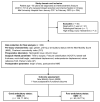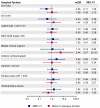Prognostic Factors of 1-Year Postoperative Functional Outcomes of Older Patients with Intertrochanteric Fractures in Thailand: A Retrospective Cohort Study
- PMID: 34199045
- PMCID: PMC8297186
- DOI: 10.3390/ijerph18136896
Prognostic Factors of 1-Year Postoperative Functional Outcomes of Older Patients with Intertrochanteric Fractures in Thailand: A Retrospective Cohort Study
Abstract
Restoration of ambulatory status is considered a primary treatment goal for older patients with intertrochanteric fractures. Several surgical-related parameters were reported to be associated with mechanical failure without focusing on the functional outcomes. Our study examines the roles of both clinical and surgical parameters as prognostic factors on 1-year postoperative ambulatory outcomes, reaching a good functional outcome (the New Mobility Score: NMS ≥ 5) and returning to preinjury functional status at one year, of older patients with intertrochanteric fracture. Intertrochanteric fractures patients age ≥65 years who underwent surgical treatment at our institute between January 2017 and February 2020 were included. Of 209 patients included, 149 (71.3%) showed a good functional outcome at one year. The pre-injury ambulatory status (OR 52.72, 95%CI 5.19-535.77, p = 0.001), BMI <23 kg/m2 (OR 3.14, 95%CI 1.21-8.13, p = 0.018), Hb ≥10 g/dL (OR 3.26, 95%CI 1.11-9.57, p = 0.031), and NMS at discharge ≥2 (OR 8.50, 95%CI 3.33-21.70, p < 0.001) were identified as independent predictors for reaching a good postoperative functional outcome. Only aged ≤80 (OR 2.34, 95%CI 1.11-4.93, p = 0.025) and NMS at discharge ≥2 (OR 6.27, 95%CI 2.75-14.32, p < 0.001) were significantly associated with an ability to return to preinjury function. To improve postoperative ambulatory status, orthopedic surgeons should focus more on modifying factors, such as maintaining the preoperative hemoglobin ≥10 g/dL and providing adequate postoperative ambulation training to maximize the patients' capability upon discharge. While surgical parameters were not identified as predictors, they can still be used as guidance to optimize the operation quality.
Keywords: Thai; fracture fixation; geriatric; intertrochanteric fractures; prognostic factors.
Conflict of interest statement
The authors declare no conflict of interest.
Figures



Similar articles
-
Development of Clinical Prediction Rules for One-Year Postoperative Functional Outcome in Patients with Intertrochanteric Fractures: The Intertrochanteric Fracture Ambulatory Prediction (IT-AP) Tool.Int J Environ Res Public Health. 2021 Dec 24;19(1):177. doi: 10.3390/ijerph19010177. Int J Environ Res Public Health. 2021. PMID: 35010437 Free PMC article.
-
Does integrity of the lesser trochanter influence the surgical outcome of intertrochanteric fracture in elderly patients?BMC Musculoskelet Disord. 2015 Mar 5;16:47. doi: 10.1186/s12891-015-0492-7. BMC Musculoskelet Disord. 2015. PMID: 25879412 Free PMC article.
-
Cephalomedullary nail versus sliding hip screw for unstable intertrochanteric fractures in elderly patients.J Orthop Surg (Hong Kong). 2013 Dec;21(3):308-12. doi: 10.1177/230949901302100309. J Orthop Surg (Hong Kong). 2013. PMID: 24366790
-
Reporting on quality of reduction and fixation of intertrochanteric fractures-A systematic review.Injury. 2021 Mar;52(3):324-329. doi: 10.1016/j.injury.2021.02.014. Epub 2021 Feb 11. Injury. 2021. PMID: 33612251
-
Hip Replacement as Alternative to Intramedullary Nail in Elderly Patients with Unstable Intertrochanteric Fracture: A Systematic Review and Meta-Analysis.Orthop Surg. 2019 Oct;11(5):745-754. doi: 10.1111/os.12532. Orthop Surg. 2019. PMID: 31663280 Free PMC article.
Cited by
-
Factors influencing mobility among people post-surgery for hip fractures: A cross-sectional study.Belitung Nurs J. 2023 Aug 28;9(4):349-358. doi: 10.33546/bnj.2759. eCollection 2023. Belitung Nurs J. 2023. PMID: 37645578 Free PMC article.
-
Comparing Intramedullary Nails versus Dynamic Hip Screws in the Treatment of Intertrochanteric Hip Fractures on Post-operative Rehabilitation Outcomes - A Systematic Review and Meta-Analysis.Geriatr Orthop Surg Rehabil. 2025 Jun 17;16:21514593251350490. doi: 10.1177/21514593251350490. eCollection 2025. Geriatr Orthop Surg Rehabil. 2025. PMID: 40535322 Free PMC article. Review.
-
Ambulation recovery prediction after hip fracture surgery using the Hip Fracture Short-Term Ambulation Prediction tool.J Rehabil Med. 2024 Oct 30;56:jrm40780. doi: 10.2340/jrm.v56.40780. J Rehabil Med. 2024. PMID: 39482980 Free PMC article.
-
Translation, validity, and reliability of the Thai de Morton Mobility Index in patients following hip surgery.Int J Nurs Sci. 2025 Apr 15;12(4):386-392. doi: 10.1016/j.ijnss.2025.04.003. eCollection 2025 Jul. Int J Nurs Sci. 2025. PMID: 40786856 Free PMC article.
-
Development of Clinical Prediction Rules for One-Year Postoperative Functional Outcome in Patients with Intertrochanteric Fractures: The Intertrochanteric Fracture Ambulatory Prediction (IT-AP) Tool.Int J Environ Res Public Health. 2021 Dec 24;19(1):177. doi: 10.3390/ijerph19010177. Int J Environ Res Public Health. 2021. PMID: 35010437 Free PMC article.
References
-
- Kulachote N., Sa-Ngasoongsong P., Sirisreetreerux N., Chulsomlee K., Thamyongkit S., Wongsak S. Predicting Factors for Return to Prefracture Ambulatory Level in High Surgical Risk Elderly Patients Sustained Intertrochanteric Fracture and Treated with Proximal Femoral Nail Antirotation (PFNA) With and Without Cement Augmentation. Geriatr. Orthop. Surg. Rehabil. 2020;11:2151459320912121. doi: 10.1177/2151459320912121. - DOI - PMC - PubMed
Publication types
MeSH terms
LinkOut - more resources
Full Text Sources
Medical

